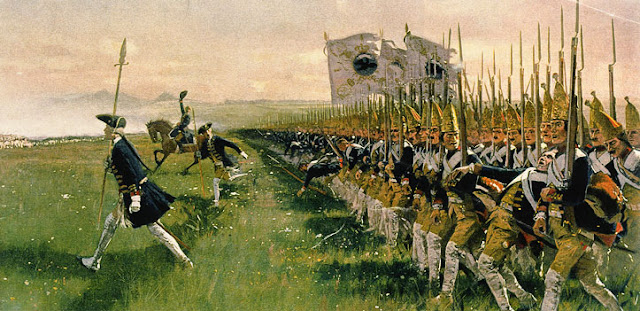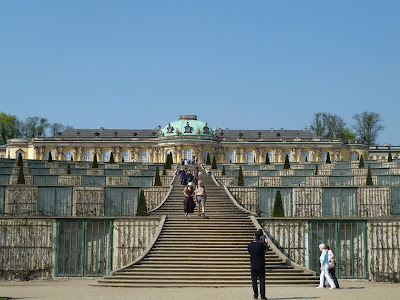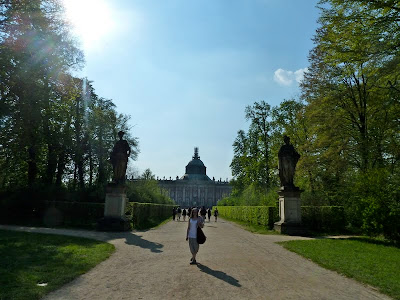Potsdam (about an hour out of Berlin) is the capital of the Brandenburg state in Germany (similar to our states having capitals in the USA). The area really is beautiful-- it doesn't have the glamour of beaches or mountain views, but this slightly forested lake is just truly serene, unassuming nature at its best. Probably for this reason, during the 19th and 20th centuries, this was where the troubled Prussian kings decided to set down their 'vacation' palaces.
First up was the Babelsberg Palace, looking fabulously mystical in a thin fog cloak across the lake. In 1833 one of the Hohenzollern family princes got permission from his father (the king) to build this summer get-away for him and his wife.
Just near here too we passed underneath the "Glienicke" Bridge which connects Potsdam to Berlin. Super cool fact: During the Cold War, this bridge was one of very few locations in the world where the US could stand face to face with the Soviets. It was here (I like to think on a chill evening past nightfall, as their trench coats billowed back in the wind) that the enemies used this bridge to exchange captured spies and political prisoners without the input of their allies in the war.


The green bridge above might look relatively generic, but this image below is actually the beginning of the bridge-- this epicocity is what you first walk through in order to cross the bridge.
We walked back through the lake area, only hitting one stretch of nude sun bathers as we went (the way the sun reflected off their naked butts made it too difficult to take a photo- my apologies). The scenery was beautiful though, so peaceful and relaxing. If was I was an overworked king of Prussia, this would be the ideal place to come and just be with nature.
This construction I actually haven't been able to identify for the life of me- it's driving me nuts! Again though, it looked lovely from across the water; this whole area felt hilariously Jane Austen sometimes, despite it being Germany.
 |
| Is there anyone who somehow can't envision an emotionally frustrated Colin Firth climbing out of that lake in a soaked through white shirt? "Ich liebe dich, Elizabeth!" Totally. |
Back in the wooded area just a bit further was a more modern 'palace' or castle. Like the others, it was built as a summer residence for another member of the Hohenzollern family (Prussian royalty), this time about 1915 and in the style of an English manor (it's now a hotel/restaurant which is probably hilariously out of my budget).
 |
| "Cecilienhof" Castle |
This palace is really best known though as the site (get this) of the 1945 Potsdam conference. Ring a bell? (It took me a minute) See if this helps:
That's right. This is where Churchill, Truman, and Stalin, the three thundering superpowers of the WWII anti-Hitler team met up after finally winning. They were in an occupied Germany which had unconditionally surrendered, and they were meeting to debate just exactly what they were going to do with their fallen enemy.
If I remember right, I believe this was where our guide said the infamous three once sat. That low stone wall looks about right compared with black/white photo, yeah? I wish I'd paid more attention- there were three of us on the trip! Would have made for a hilarious photo opp (I would SO have been Churchill, just for the record).
Also hilarious: apparently, the Soviets arrived at the occupied castle first and as mature, perfectly sane adults, they decided to welcome their allies with a massive flowery Soviet star planted right in the middle of the garden. Although in reality, this probably deserves serious analysis as a head game because Stalin was nuts, I secretly imagine Churchill and Truman chortling heartily over what a great prank it was.
 |
| Holländisches Viertel |
For lunch we stopped in here, a town constructed in the 18th century. Potsdam was attracting a huge number of foreigners about that time, largely refugees looking to live in peace or to find religious tolerance (many French Huguenots and Jews). However, King Wilhelm I was also very interested in Dutch craftsmanship, and in an effort to attract them, he had this row of some 130 houses built in a traditional Dutch style. The area is now called the "Holländisches Viertel" or The Dutch Quarter. Although we tried to have lunch at a local shop, the town was just too slow-paced for our rushed schedule; we had to abort and run back over to the Japanese shop our guide had recommended. Haha, curiously enough, the food was actually really good.
We ventured onward through the market area then, past several shops I would have loved to have gone into if we'd had time! At the edge of the city was a second Brandenburg Gate (the main one being the Gate in central Berlin).
This one, as you approach from inside the city, looks relatively plain. Though there's some nice detail and it's well designed, the presentation is clean and uncomplicated. What we found out was that this inner, less impressive side was actually designed by the lead sculptor (Karl von Gontard).
The student, however, (Georg Christian Unger) was believed to have fully surpassed his master in the design of the outer side of the gate. This does seem to be the case, although I have to feel bad for poor Karl who was probably explicitly told the inside didn't have to be quite as fancy in design as the outside.
We next reached the Obelisk Entrance (built about 1747) for the grand park where Frederick the Great's summer palace sits.
Fun fact: this obelisk was constructed before the Rosetta Stone was discovered-- this means that those hieroglyphics are just cool looking jibberish.
It's a bit difficult to tell here, but the figures at the top of these columns both face forwards, into the park. This is because this was originally used only as an exit, and this way the figures could "bid farewell" to the guests as they left.
The gardens lead you through to the grand center. Again, for the life of me, I cannot find out what the heck these trees are called- they seem to be all over central Germany (in Hamburg and Berlin too). After a good hour of googling with no luck, I'm becoming fairly certain that all Germans are aliens who brought these trees back from their home planet.
Our next real palace was the Sanssouci, constructed around 1747 for a stressed out Frederick the Great (King of Prussia). According to our guide, he wanted a summer residence away from the pomp of Berlin and, even more than that, away from his wife, who was not allowed to visit here.
Frederick the Great was a cool freaking dude. His childhood was nothing short of utterly wretched: as an 18 year old interested in philosophy and music, he tried to flee his crazy war-happy authoritarian father by running away to England with his best friend. Naturally, the king caught the kids. Unnaturally, he forced his son to watch as his best friend was beheaded in front of him.
Yet, somehow, despite all this horror, Frederick the Great grew up into an intelligent, cultured, wise king. He regularly corresponded with Voltaire. He wrote flute music. When asked how he wanted to be buried, he always asked for something simple, humble, without all that pomp and circumstance. He also explicitly told his troops that if he was killed in battle, they were to just bury his body wherever was convenient, then they could come back for it in the winter.
This leads into another point of why he was such a cool dude: he was also a badass, plain and simple. During his reign, not only did he modernize the entire political system and promote great tolerance while sponsoring the arts, he also united most of Prussia underneath him. Want to know how? Check this out:
 |
| Guess who's in front plowing forwards with that "your sorry arses are mine" look on his face, even as bullets are whizzing past him taking out other mortal Prussian soldiers in the background... |
At any rate, here's the base of the steps leading up to the palace. Haha, it seems the architects of the palace really wanted to put the building itself on yet another raised platform, so it would look more impressive than it does here, sort of getting swallowed by the view of the steps. However, understandably, Frederick was not really into the idea of having to climb any more stairs than he had to while on vacation and said absolutely not.
The odd set of rising walls next to the stairs actually hold little gated terraces for growing figs and grapes. Frederick was very big on combining art with nature.
The name of the palace reflects its French inspiration; it translates to "without concerns."
Frederick the Great loved this palace so much he asked to be buried here, not next to his wife, but next to his prized horse and pet wiener dogs (true fact). When Fred died in his favorite armchair here though, his heir (who was actually his brother's son) thought it more appropriate to bury him in the Potsdam garrison. Thus began the fascinating travels of him post-death (even the man's lifeless body was awesome): so during WWII, the Germans rescued their old king's coffins and placed them first in an underground bunker and then in a salt mine, saving them from the bombs. However, this did not save them from snooping US soldiers, who found the coffins and randomly (truly, I have no idea why) carried them some 300 miles to Hesse in the Marburg state. A few years later they were transferred again, this time from the church they'd be staying at to a castle somewhere else in Germany. Finally, another four decades after that, on the 205th anniversary of his birthday, Fred the Great was brought back to Potsdam and laid to rest as he had originally requested, with simplicity and next to his beloved pets.
To this day, just as a testament to all the man accomplished, people still bring ribbon-wrapped potatoes to lay on the grave as a sign of respect (there were a few baking in the sun when we arrived). The potatoes as a symbol derive from Frederick's using them as one of the new crops introduced to help transform Prussia into a powerful, competitive, productive land.
As we moved on through the gardens, we also walked past the "Historic Mill." The story surrounding this is a quirky little piece: The miller, upset that the king's new palace was blocking the wind from his mill, sued the royalty and actually won for the first time in history. Frederick was cool about the whole thing though, especially since he actually like the sound of the mill and found it soothing, and bought the guy a brand new mill. The old one stayed put here though from 1738 until it was nailed by a Russian bazooka in WWII (obviously it did not survive). However, in 1991 they finally had enough money to rebuild the popular little landmark.
Again: more tree tunnels- this time slightly less alien.
This next palace was actually not one of Fred's. Instead, it was built Friedwich Wilhelm IV around 1860. It's called the "Orangery," and from what I can tell, this name means about what it sounds like: it's a greenhouse where oranges are grown. It was also the last structure to have been erected in this Sanssouci area.
Finally, we reached the last palace of the day, the "New Palace." That's not a German word- it's literally referred to as the New Palace. As you might have guessed though, this is ironic as (like most things in Europe) it is actually not that new at all. This was another construction by Frederick the Great completed about 1769, built to commemorate all the ass-kickings that he handed out during the Seven Years' War.
The New Palace is a masterpiece of Prussian baroque style, and is especially symbolic as the manifestation of Prussia's glory.
The palace itself was not residential in purpose, but rather served as a meeting place for prominent visitors, be it for political conferences, theatrical performances, or enormous dances. I loved that the lead up to it was completely plain: no trees, no bushes, no fancy flowers. The view was of raw palace, the glory of Prussia sitting smack in the middle of the clearing.
So finally, what was that, five palaces? Six? Ordinarily, I would totally try to say something more intelligent than "holy cow, Germany, this was epic," but it is unfortunately noon in the last week before my family comes to visit and I need to catch up on more than just blogs!!! Again though, I am so grateful-- getting to see these palaces was like catching a glimpse at the more personal side of royalty, seeing where they went to escape from it all.

































No comments:
Post a Comment